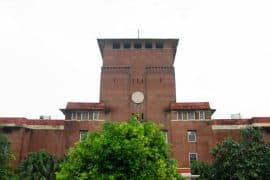The popular Amrit Udyan or Mughal gardens has reopened for visitors, this time with a new selection of summer blooms. Here is a quick guide to planning a nice visit to the gardens and appreciating the flora and rich heritage of the Rashtrapati Bhavan complex.
Amrit Udyan, also known as the Mughal Gardens, is a renowned tourist destination in the complex of Rashtrapati Bhavan, the President’s residence. It is known as the heart and soul of the palace and is a lovely spot to visit that is only available for a short time each year from February to March during spring. It is so well-known that when I first arrived in Delhi as an outstation student, it was on my list of things to do. It was highly recommended to me by my relatives who had previously visited the location or by my Delhi peers.
I prepared an entire day with friends to visit these gardens in order to truly experience the buzz. It’s a great moment to share my thoughts from that getaway because, for the first time, the gardens will be open for a month from August 16th to September 17th, highlighting the summer blossoms. It’s a fantastic chance for tourists and students to spend time admiring the flora and fauna while also getting a sense of the ambiance surrounding the historical building of the Rashtrapati Bhavan.
To begin, all visitors should go to the official website rashtrapatisachivalaya.gov.in to book tickets to the garden according to their preferred time slot and gloss over any other information. The entry fee is absolutely free, however a digital pass is required to enter the premises.
Avoid booking tickets on busy days because the venue will be extremely crowded. The Central Secretariat Metro Station is the closest, from which you can take an auto to the Gardens. The Rashtrapati Bhavan’s Gate No. 35, along North Avenue, will be used for entry. Since the weather in the city may be fairly variable, I would advise you to wear comfortable shoes and clothing on the day of your visit. Since you are visiting a high security zone, your baggage will be searched, so be aware of your possessions and try to bring as little as possible. The less you pack, the more enjoyable your outing will be.
Inside the premises, there is also a lovely white building complex known as the Rashtrapati Bhavan museum complex, which is another impressive symbol of legacy that you may visit to learn about the place’s history and heritage. One of a kind in the nation, it is a visitor-interactive storytelling museum.
Returning to Amrit Udyan, the enormous campus is home to a variety of beneficial herbal plants, which my friends from Botany field were thrilled to see. Each plant had a little tag with its common and scientific names on it. President Kalam created these herbal gardens, which comprise a wide range of therapeutic and fragrant plants. Beautiful fountains and flower species such as roses and tulips adorn the area. The scent of many plants and the soothing sound of bees is another feature of the place that you won’t find anywhere else in the busy city of Delhi.
While the Gardens is inspired by the famous Mughal gardens of Jammu and Kashmir, as well as those surrounding the Taj Mahal. It is influenced by both Indian and Persian architectural styles. Edwin Lutyens completed the designs for the Mughal Gardens in 1917. For the gardens, Lutyens combined two distinct horticultural traditions: Mughal design and English flower garden. The gardens were developed over time by many presidents who resided in the complex, and presently the complex includes the East Lawn, Central Lawn, Long Garden, and Circular Garden, Herbal-I, Herbal-II, Tactile Garden, Bonsai Garden, and Arogya Vanam.
One of the key sites is in the backdrop of Rashtrapati Bhavan, where tourists can observe the rear of the gorgeous monument, which is covered with numerous lines of flowers. The rectangular gardens are the most well-known places that showcase the Bhavan’s complex. However, professional cameras and drones are not permitted onto the site. Photographs can be taken with cell phones. For individuals who are interested in nature photography, their mobile camera can be used to capture the lovely blooms and the surrounding scenery. Personally, I liked the spot of Circular lawns the most because it included a fountain and a pond in the centre, as well as an amphitheatre-like structure with flower beds surrounding it. It is worth noting that there is also distillation equipment for the extraction of essential oils from the Rashtrapati Bhavan Gardens’ aromatic and herbal plants.
One can end their evening after a thorough tour of the facility by either purchasing refreshments from the complex or visiting several nearby cafés, like in Connaught Place. The outing to Amrit Udyan was quiet and serene despite the fact that it was expected to be crowded. It’s a moment to look at nature’s beauty and the marvel of life and evolution. It’s also crucial to grasp the gardens’ historical significance and the memories of those who have lived and nurtured the landscape for years. It’s possibly the most well-known gardens in India because of its connection to the country’s heritage.
It’s a low-key, low-cost option to spend time in nature away from the rush and commotion of the city.
Read Also – https://dubeat.com/2023/02/11/dubtravels-silent-nights-in-sunder-nursery/
Image Credits – Writer’s collection
Priya Agrawal





Comments are closed.